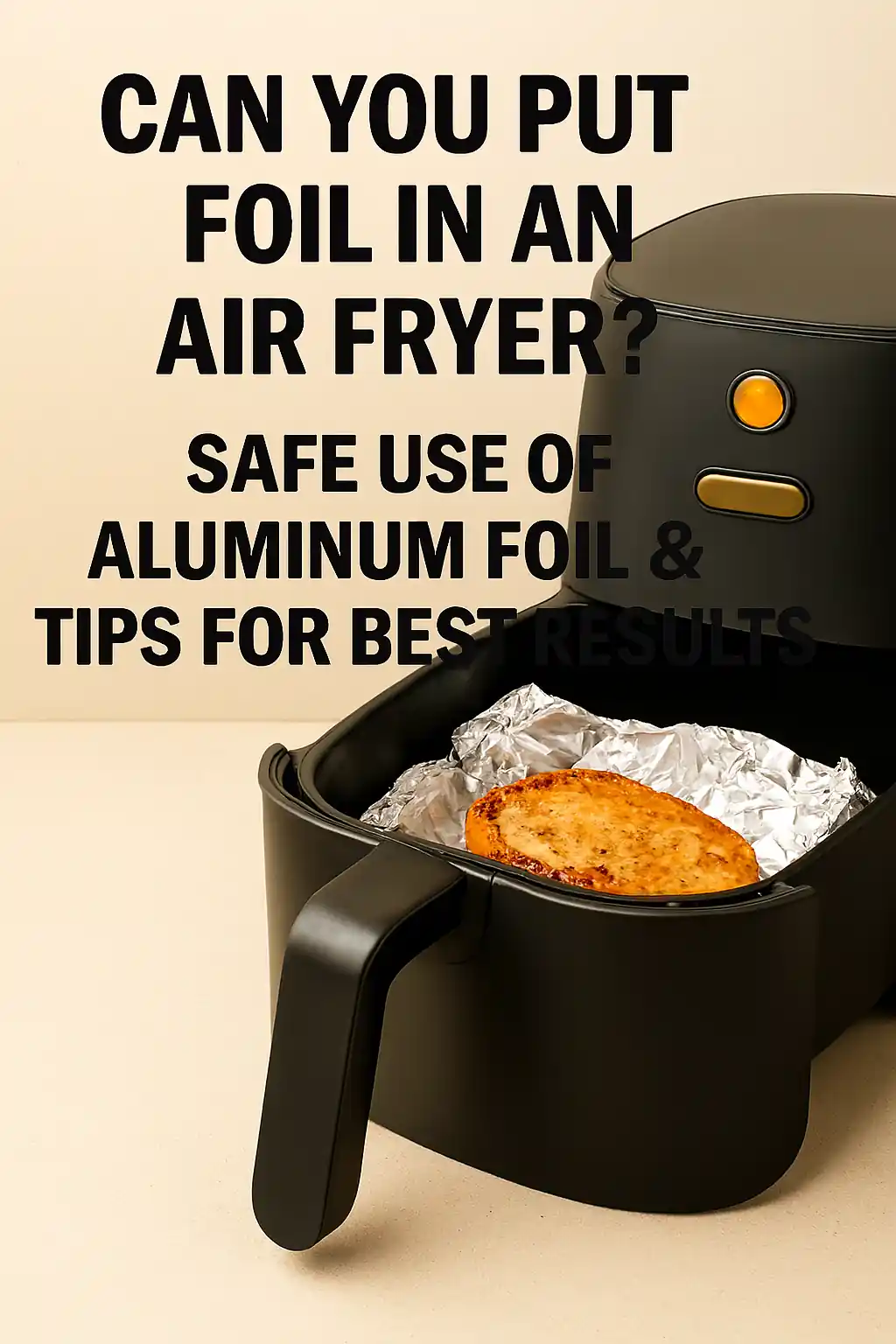Foil in Air Fryers: Can You Put Foil in an Air Fryer Safely?
Introduction to Foil in Air Fryers
Air fryers have revolutionized home cooking, providing a quick and healthier way to prepare crispy foods without deep frying. This innovative kitchen appliance uses convection heat and rapid air circulation to cook food evenly, creating that irresistible crunch with less oil. However, as air fryers have grown popular, many users ask a common question: can you put foil in an air fryer?
Using aluminum foil in an air fryer can be beneficial for cleanup and food preparation, but it also requires some caution to avoid disrupting the cooking process or damaging the appliance. This comprehensive guide will explore the pros and cons of using foil, how to do it safely, alternatives like parchment paper, and tips to get the best results while keeping your air fryer in top condition.
Understanding Air Fryers and Their Cooking Mechanism
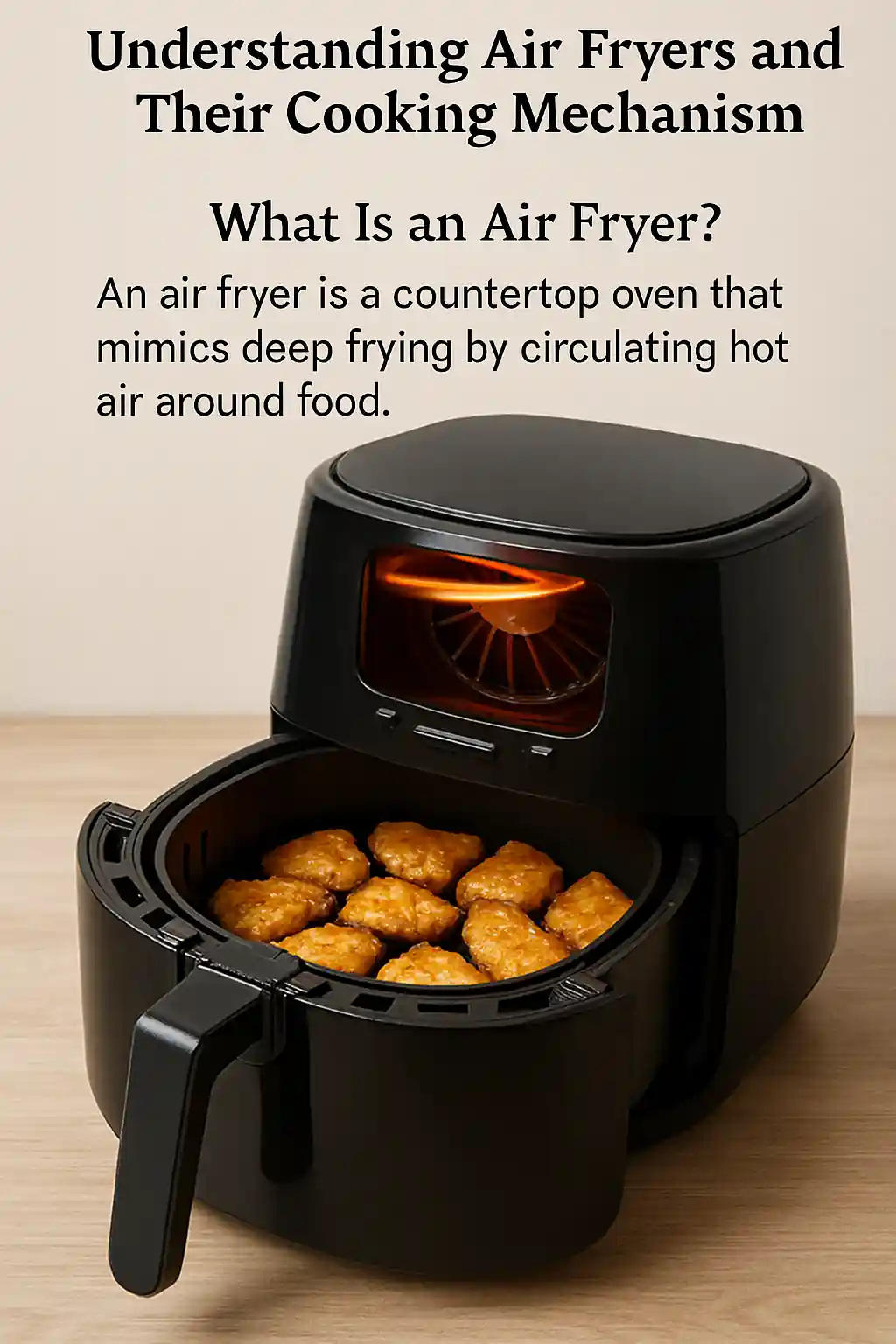
What Is an Air Fryer?
An air fryer is a countertop oven that mimics deep frying by circulating hot air around food.
If you’re new to air fryers or looking to find the best model for your kitchen, check out our best air fryer guide with Instant Pot air fryer reviews for expert tips and recommendations.
The appliance typically includes a basket or tray where the food is placed. A heating element and a powerful fan work together to produce convection heat, cooking the food evenly and quickly.
How Does Convection Heat Work in Air Fryers?
Convection ovens work by moving hot air continuously around the food. This rapid circulation removes moisture from the surface of food, creating a crispy texture. The basket or tray in an air fryer is often perforated to allow this airflow to reach all sides of the food.
Why Airflow Is Critical
For air frying to work properly, the circulation of hot air must be unobstructed. Any object, such as aluminum foil, that covers the holes in the basket or blocks vents can disrupt this airflow, leading to uneven cooking or longer cooking times. Therefore, when using foil, it’s essential to ensure it does not block air circulation.
Can You Put Foil in an Air Fryer?
Is It Safe to Use Aluminum Foil in an Air Fryer?
Yes, it is safe to put aluminum foil in an air fryer when done correctly. The foil can help line the basket, wrap food, or cover parts of the basket to keep it clean. However, improper use may disrupt airflow or cause foil to come into contact with the heating element, which can be dangerous.
How to Use Foil Safely in an Air Fryer
-
Leave space for air to circulate: Do not cover all the holes in the basket. The perforations allow convection heat to circulate properly.
-
Do not block the air vents: Avoid placing foil near the heating element or vents.
-
Secure the foil: Make sure the foil is weighed down by food so it doesn’t blow around.
-
Avoid acidic foods: Aluminum foil can react with acidic ingredients like tomatoes, vinegar, or citrus, potentially affecting flavor and safety.
-
Use the right foil thickness: Thicker foil is less likely to tear or blow around.
Benefits of Using Aluminum Foil in an Air Fryer
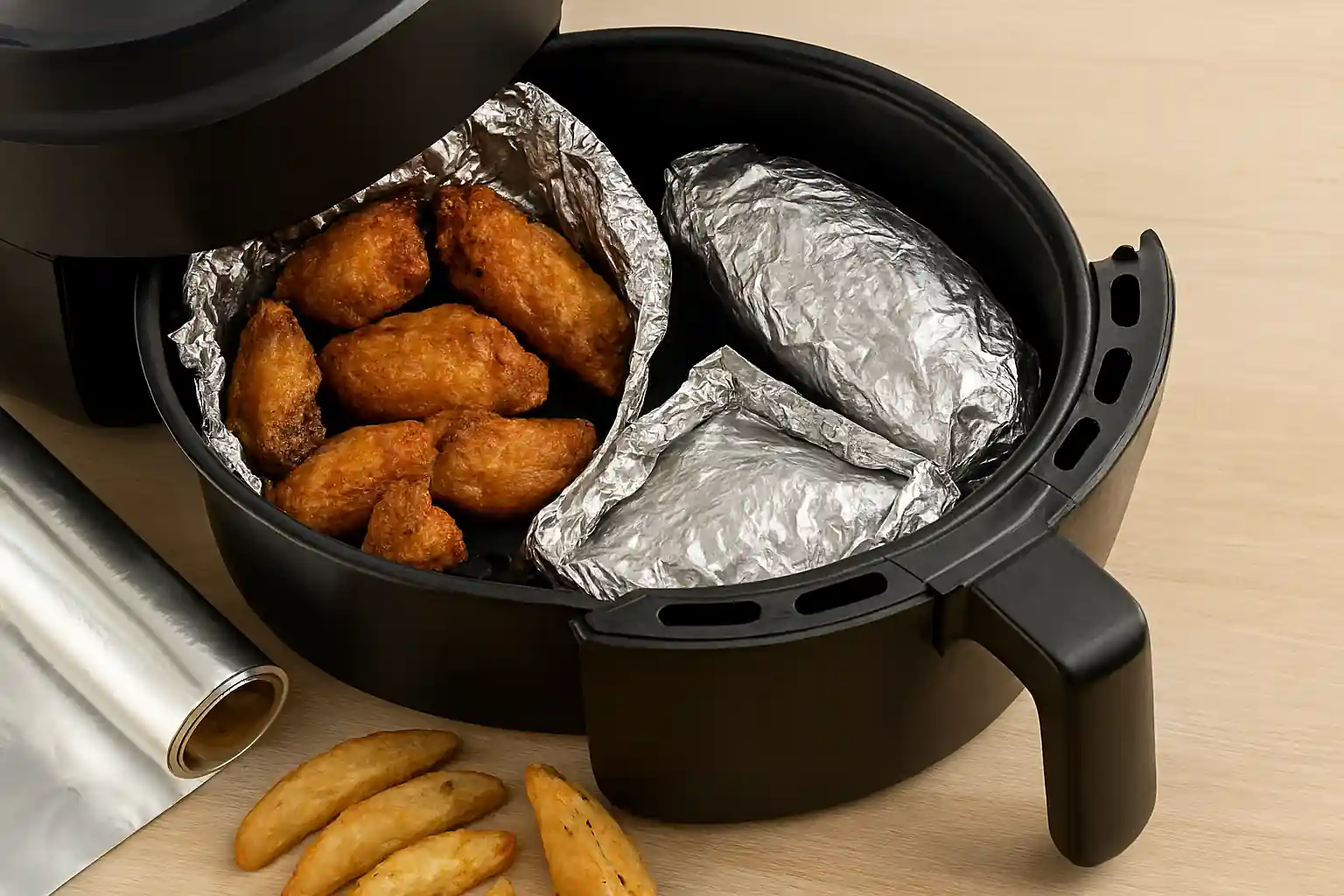
Easier Cleanup
Using foil to line the basket or tray can catch drips and crumbs, making post-cooking cleanup easier. Instead of scrubbing stuck-on grease, you can simply remove and discard the foil.
Enhanced Cooking Performance for Certain Dishes
Wrapping food in foil can help retain moisture and cook food more evenly. For example, when cooking chicken wings or potatoes, foil wrapping keeps juices inside, preventing drying.
Versatility in Cooking
Foil allows you to cook delicate foods, like fish, by wrapping them to protect against direct heat, preventing them from breaking apart in the basket.
Common Mistakes When Using Foil in Air Fryers
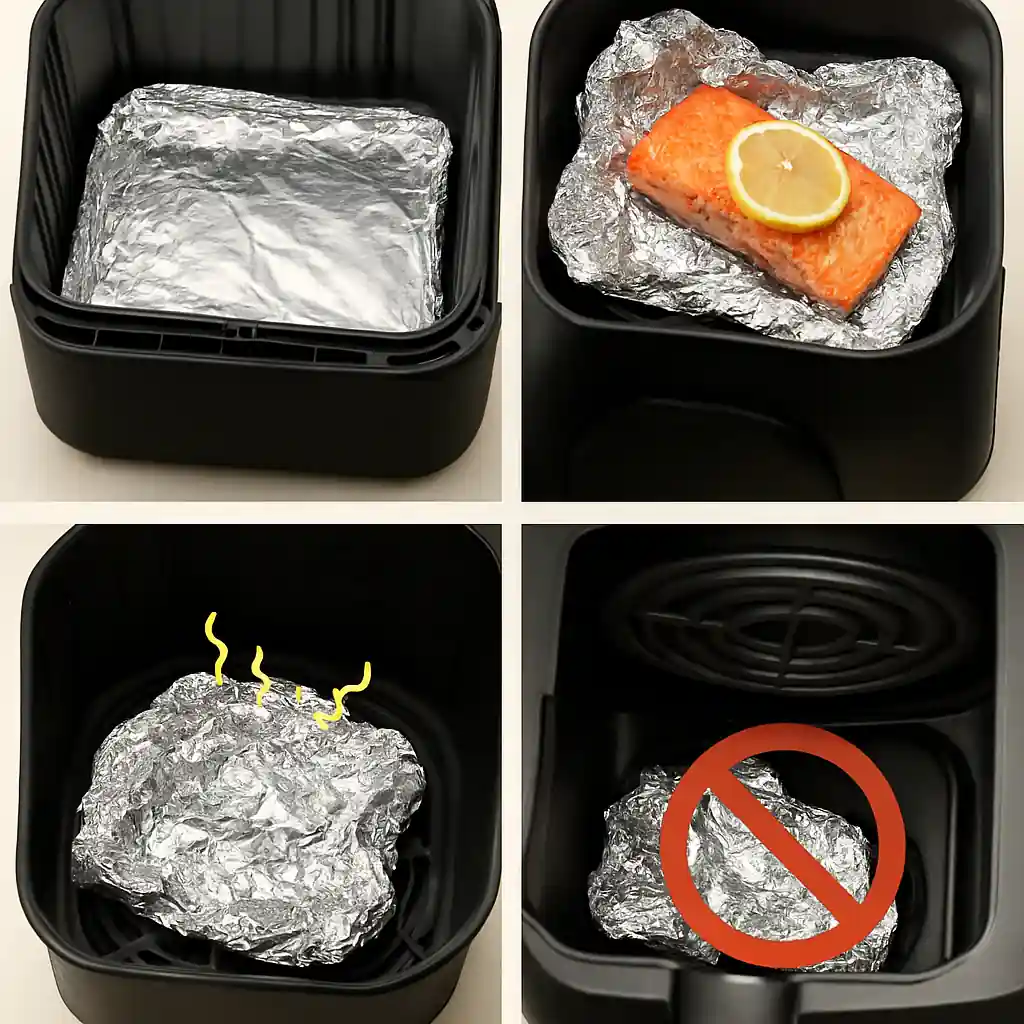
Blocking Air Circulation
The most common mistake is covering the entire bottom of the basket with foil, which blocks airflow. This disrupts convection heat and causes uneven cooking.
Using Foil with Acidic Foods
Cooking acidic foods in direct contact with aluminum foil can cause a chemical reaction that may alter the taste and degrade the foil.
Leaving Foil Loose
If foil is not secured under food, it can blow around inside the fryer, potentially touching the heating element and causing sparks.
Covering Air Vents or Heating Elements
Avoid placing foil near vents or heating elements, as this could cause overheating or damage.
How to Properly Use Foil in an Air Fryer
Lining the Basket or Tray
To use foil effectively, line only the bottom or sides of the basket, leaving holes exposed for airflow. This method helps keep the basket clean without blocking convection.
Wrapping Food
Wrap food loosely in foil to trap moisture but allow steam to escape. This technique is especially useful for roasting vegetables or baking potatoes.
Using Foil in an Air Fryer Oven
Air fryer ovens often have removable trays or baking sheets. You can line these with foil as you would in a traditional oven, making cleanup simpler.
Preventing Foil from Moving
Place food on top of the foil to hold it down or create small perforations in the foil to allow airflow while securing it.
Alternatives to Aluminum Foil: Parchment Paper and Silicone Liners
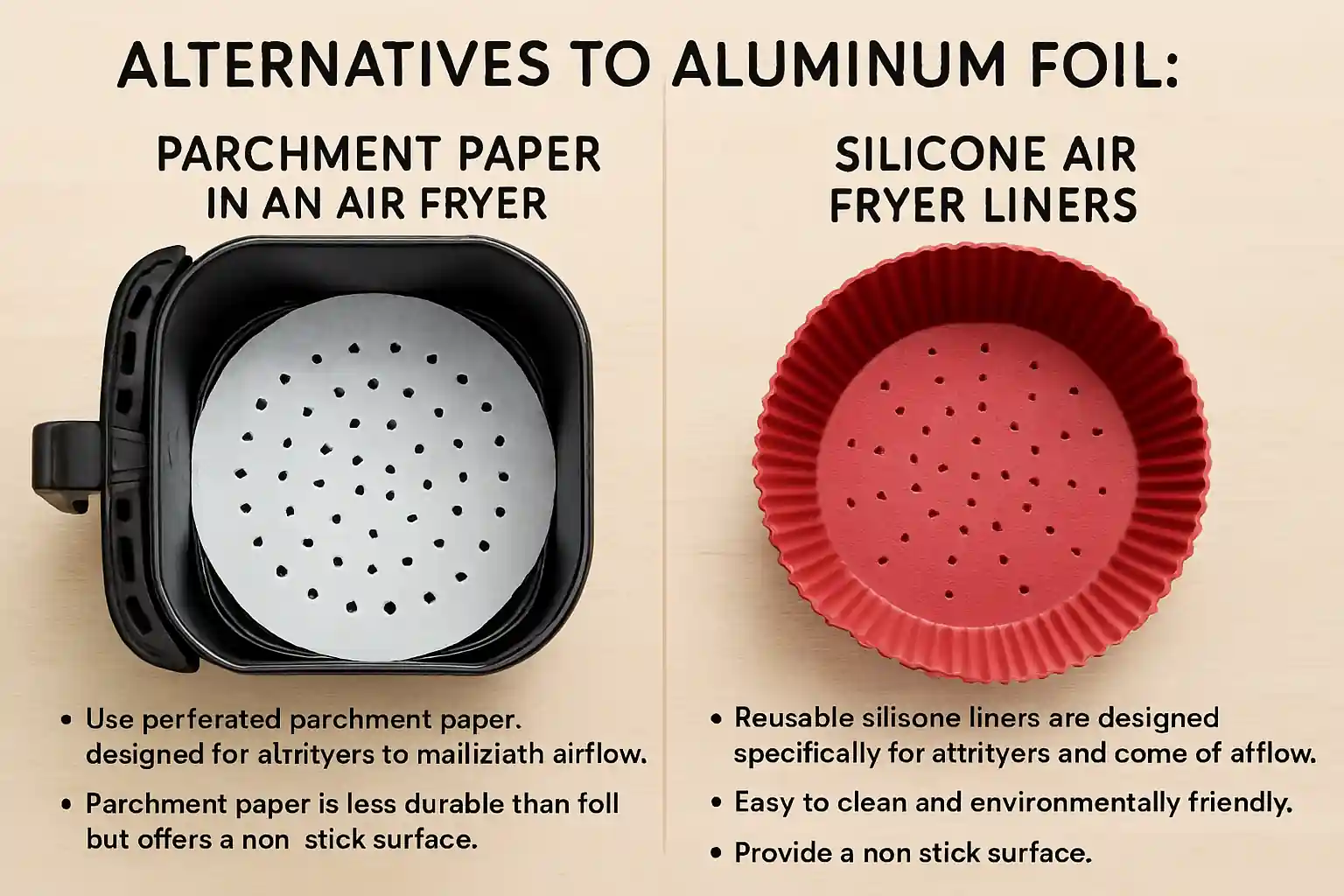
Parchment Paper in an Air Fryer
Parchment paper, also known as baking paper, is another popular liner option. It is heat-resistant and does not react with food, making it suitable for acidic dishes.
-
Use perforated parchment paper designed for air fryers to maintain airflow.
-
Parchment paper is less durable than foil but offers a non-stick surface.
Silicone Air Fryer Liners
Reusable silicone liners are designed specifically for air fryers and come with holes for airflow.
-
Easy to clean and environmentally friendly.
-
Provide a non-stick surface.
-
Do not react with food.
Comparing Foil and Parchment Paper in Air Fryers
| Feature | Aluminum Foil | Parchment Paper |
|---|---|---|
| Heat Resistance | High | Moderate |
| Airflow Impact | Can block if misused | Usually better airflow |
| Reaction with Acids | Possible | None |
| Ease of Cleanup | Disposable, easy | Disposable, less durable |
| Reusability | Mostly single-use | Mostly single-use |
Tips for Using Foil and Parchment Paper in an Air Fryer

-
Do not cover the entire basket bottom — leave holes exposed.
-
Secure the liner with food to prevent movement.
-
Avoid placing liners near the heating element.
-
Use thick foil to prevent tearing.
-
Consider perforated liners to improve airflow.
-
Monitor cooking times, as liners can affect heat transfer.
Detailed Guide to Using Aluminum Foil in Different Air Fryer Types
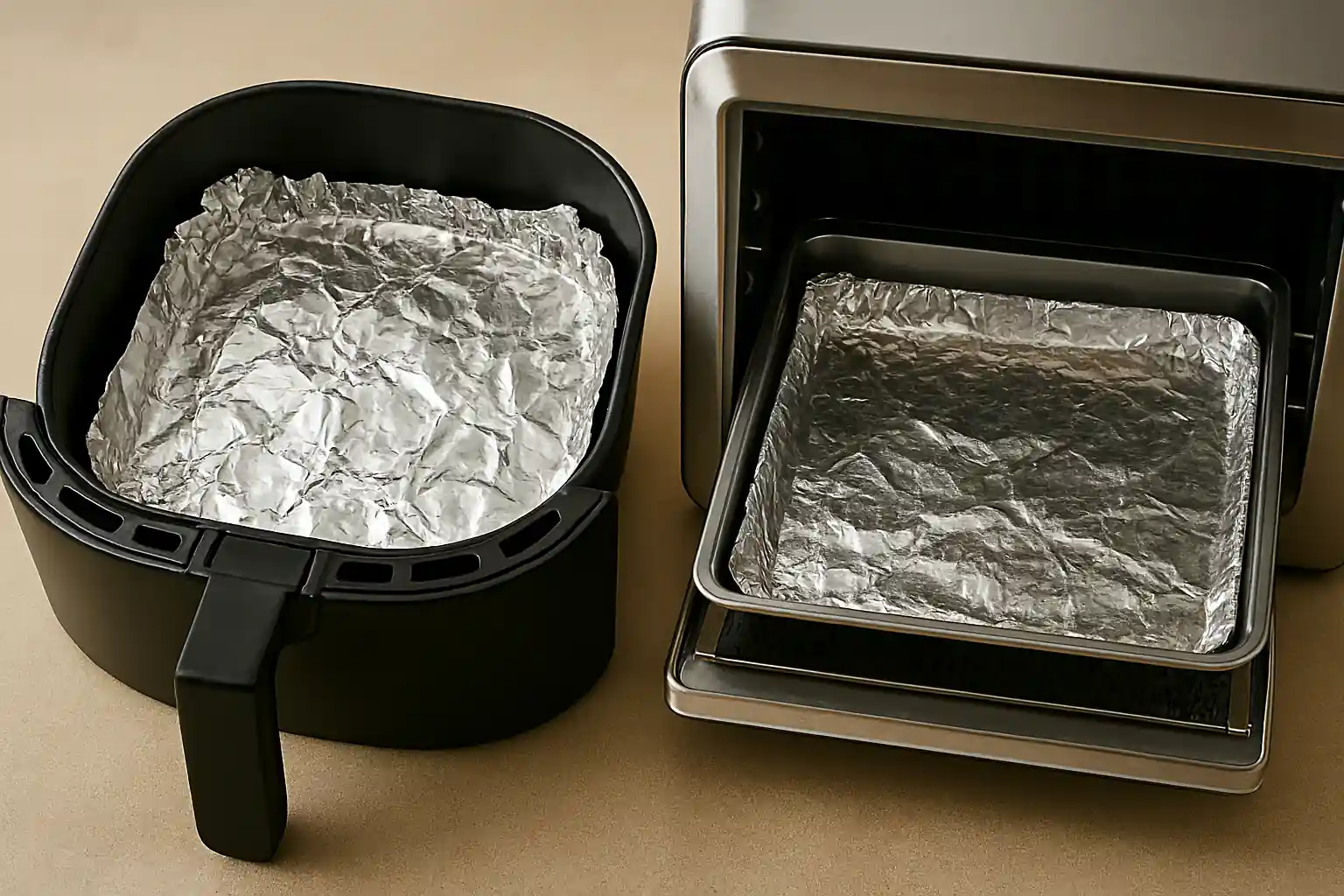
Basket-Style Air Fryers
-
Ideal for lining the basket with foil.
-
Always leave space around holes.
-
Great for smaller portions.
Air Fryer Ovens and Countertop Ovens with Air Fry Capabilities
-
Use foil to line baking trays.
-
Allows cooking larger batches.
-
Similar to conventional oven use.
Cooking Specific Foods with Foil in an Air Fryer
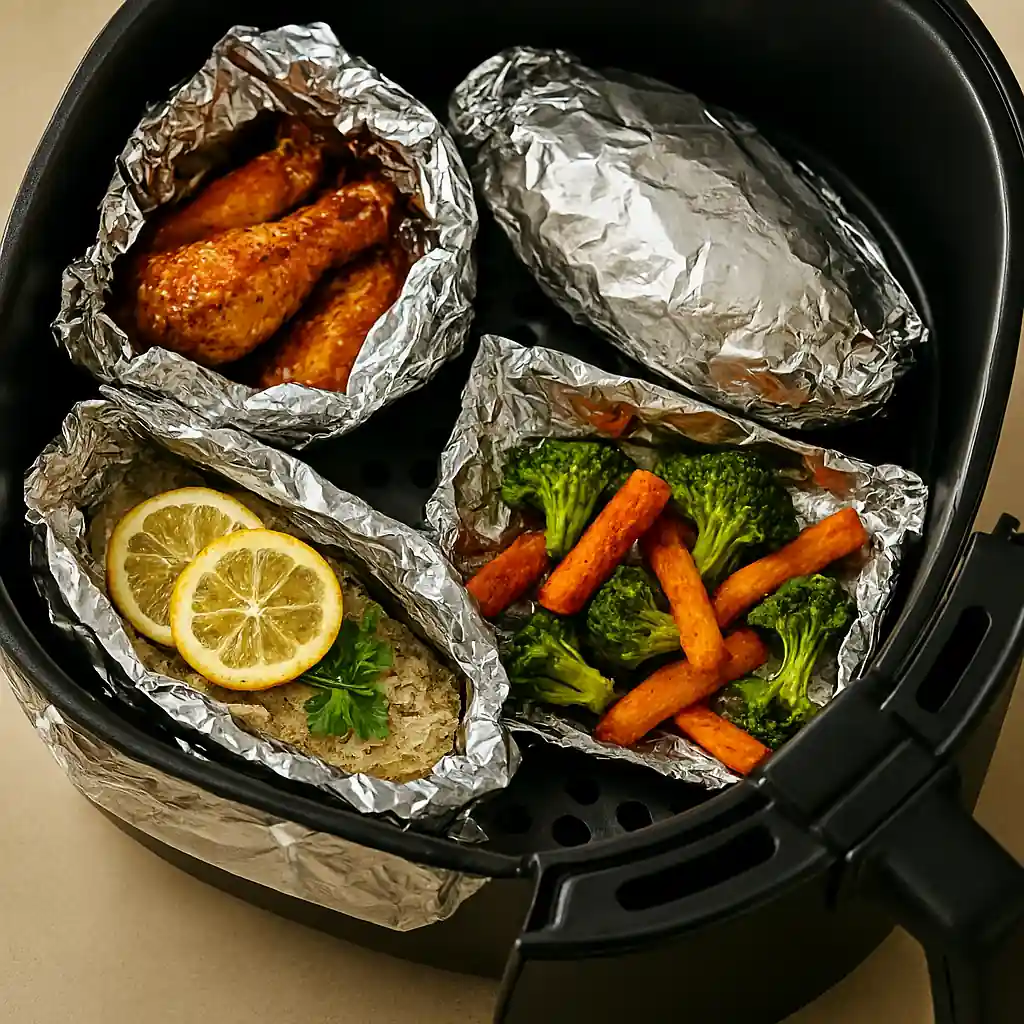
Chicken Wings
Wrap wings loosely in foil to retain moisture but avoid fully sealing to keep skin crispy. Use foil to catch drips underneath.
Baked Potatoes
Wrap potatoes completely in foil for moist, evenly cooked insides with tender skins.
Fish and Seafood
Wrap fish fillets in foil packets with herbs and lemon for gentle steaming.
Vegetables
Line the basket with foil and roast veggies for easy cleanup and even cooking.
Maintaining Your Air Fryer When Using Foil
-
Remove foil immediately after cooking to prevent damage.
-
Clean the basket regularly to avoid residue buildup.
-
Avoid sharp edges on foil that can scratch non-stick coatings.
-
Follow manufacturer guidelines on foil use.
Troubleshooting Common Issues with Foil in Air Fryers
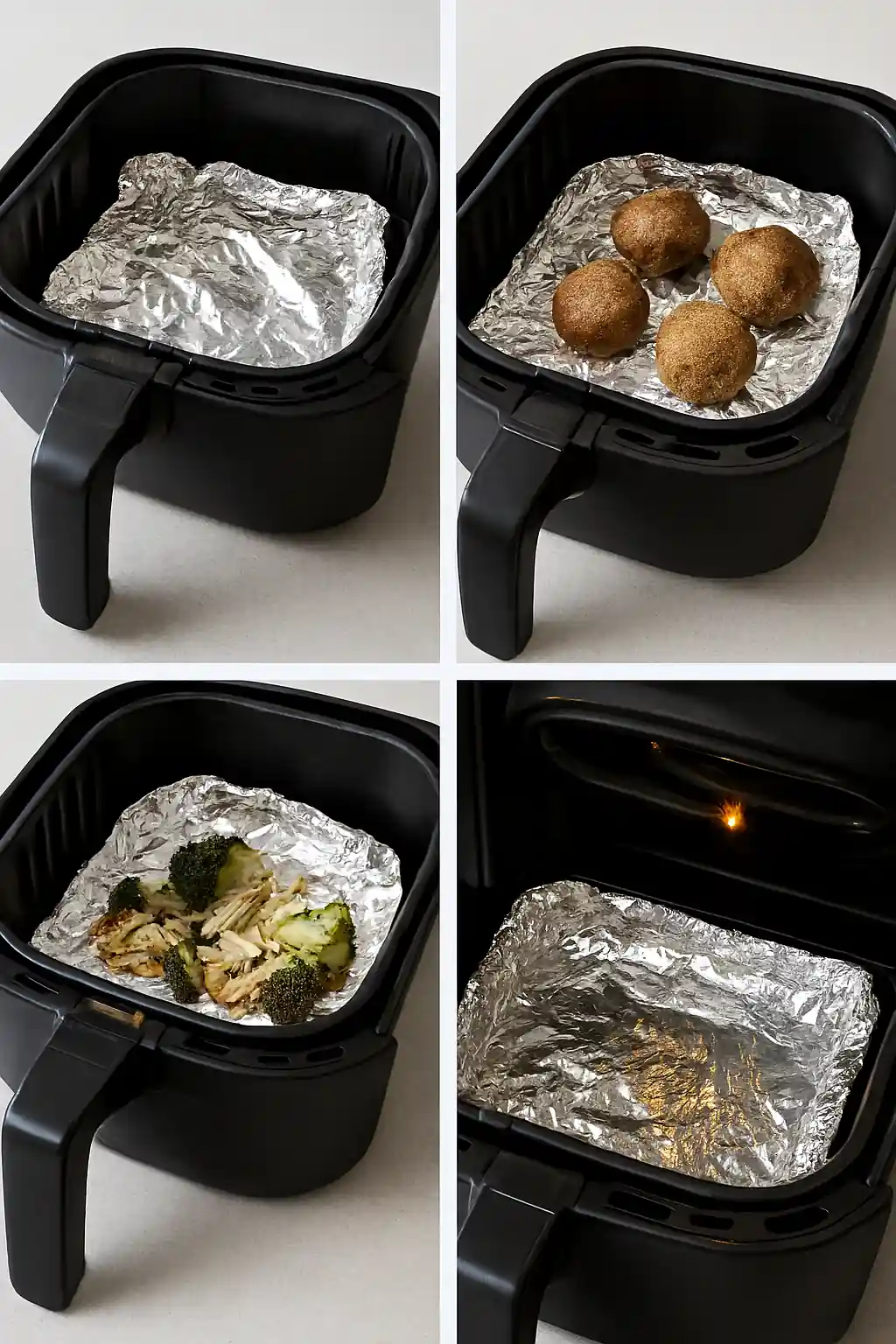
| Problem | Cause | Solution |
|---|---|---|
| Foil blowing around | Foil not secured | Weigh down with food or add perforations |
| Food unevenly cooked | Airflow blocked by foil | Leave basket holes exposed |
| Metallic taste | Acidic foods in contact with foil | Use parchment paper instead |
| Sparks inside fryer | Foil touching heating element | Adjust foil placement |
Expert and Manufacturer Recommendations
Many air fryer manufacturers suggest using foil carefully to avoid blocking air vents or heating elements. Some recommend parchment paper as a safer alternative for certain foods. Always consult your air fryer’s manual for specific guidance.
Conclusion: Is It Safe and Practical to Put Foil in an Air Fryer?
Using foil in an air fryer is safe and practical when done correctly. It can make cleanup easier, help cook certain foods better, and protect your fryer basket. However, improper use can disrupt airflow, cause uneven cooking, or even damage the appliance.
By following the tips provided here—such as leaving holes uncovered, securing foil properly, and avoiding acidic foods—you can confidently use aluminum foil in your air fryer and enjoy delicious, evenly cooked meals.
🍖 Enhance Your Air Fryer Cooking
For more tips on maximizing your air fryer experience, check out our guide on using foil safely in your air fryer. It offers insights into when and how to use foil to achieve optimal results without compromising safety or performance.

